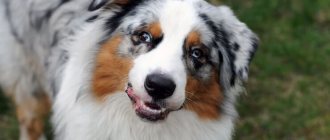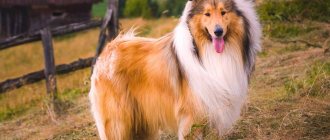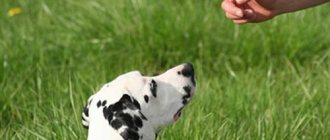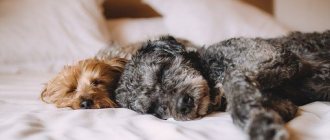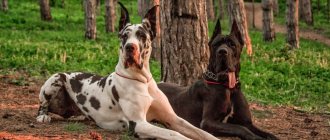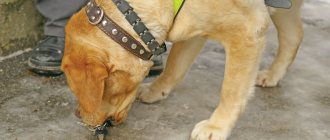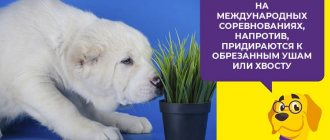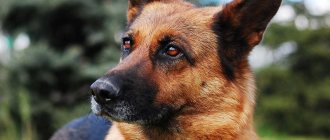Short-haired Collie – (Welsh “collye”) or Scottish Sheepdog, one of the oldest dog breeds that came from distant Britain, was originally a representative of herding dogs, now used more for ordinary life in the family as a pet.
- It will be a good option for people who dream of a Collie, but do not have the opportunity to adopt a long-haired animal.
Representatives with shorter hair have slight differences not only in appearance, but also in character, but the general similarity is almost the same.
He has an excellent character, a quick ability to learn, and will be a loyal friend and devoted companion to his owner and family.
Origin story
Short-haired collies came from the British Isles; there is reliable information that the Scottish representatives were the ancestors of the breed; there is an opinion that they were brought by the Romans.
Historians believe that at this time in Rome itself, there were already shepherds. But the fact of the presence of roots is definitely there, as is the presence of English breeds and greyhounds in the ancestors.
They gained wide popularity at the end of the 16th century, receiving the name North English Cattle Dog.
In the period from the 18th to the 19th centuries, the population grew significantly, matings also occurred with long-haired representatives, and later the two types of wool were separated.
Not all countries in the world have yet recognized them as different breeds; America is confident that they are one breed - collie, but with different types of coat presentation. The British believe that animals are different. The first standard for their differences was adopted at the end of 1974.
Russian history
Collie gained her popularity at the time of the release of the film “Lassie”; at that time, a huge number of individuals were bred and sold, no one really paid attention to her external or internal qualities. Throughout the late 80s, people wanted this particular dog.
- At this moment, a certain type of marriage began, which forced us to reconsider our attitude towards the breed as a whole. The desire to see a smart pet from a movie in your home led to the fact that puppies were sold in larger quantities, there were numerous matings, and breeders did not particularly care about quality.
As a result, people got problem dogs that had a terrible, uncontrollable character and increased aggression. This was one of the turning points, popularity waned, and real experts of the breed began to select the best representatives for mating.
It took a lot of time to get the animal in order; modern representatives are distinguished by other qualities.
Short-haired animals came to the Russian Federation and the countries of the former CIS only after the 90s, some are still confident that all collies are long-haired dogs. Now these are balanced animals that have nothing in common with the pets from the 80-90s.
History and breed standard
The homeland of short-haired and long-haired collies is Northern England and Scotland. Some experts are trying to find the ancestors of short-haired collies back in the ancient Roman period. It is possible that sleek representatives of dogs similar to modern collies appeared then, but it is more likely that short-haired collies descended from their long-haired counterparts. When brought from Scotland to northern England in the mid-19th century, black and white collies were crossed with greyhounds.
The first short-haired collies appeared at the all-breed dog show in Birmingham in 1860 in the herding class, they were exhibited as a variation of the already popular long-haired collie. In 1870, short-haired collies were given a separate ring. Some nurseries began to specialize exclusively in short-haired collies, while others continued to work on collies without dividing them into subspecies. And this situation continues in our time, for example in the USA, where there is no division of collies into different breeds, depending on the length of the coat.
By the end of the 19th century in Britain and Europe, both varieties of collie were recognized as independent breeds. The ancestor of the short-haired collie is considered to be a tricolor male born in 1873. The main purpose of short-haired collies is also herding and guarding livestock.
In Russia, the first short-haired collies appeared only in the late 80s of the 20th century. First, under the USSR, they were brought to the Republic of Estonia from Finland, then in 1993 to Novosibirsk and Leningrad. Then dogs appeared in both Moscow and Tomsk. In 2008, the first dogs arrived in Belarus, then in Ukraine and Kazakhstan. The popularity of the breed is gradually increasing; in Russia alone, 80 purebred short-haired collie puppies have been born in recent years.
According to the ICF classification, the short-haired collie belongs to group 1: Herding and cattle dogs (except Swiss dogs), section 1: Shepherd dogs, standard No. 296, without working tests. The current standard was approved in 2009.
Appearance and standard
Smooth Collies are beautifully built, with a straight, elongated back and good muscle mass. Dryish, quite strong.
- The body and body have a slight elongation, a wide chest, of a deep type. The loin is not short, straight.
- Neck and head: the neck is of medium length, not short, developed, and has a bend. Almond-shaped eyes. The color of the iris is brown; representatives have blue eyes and blue merle coloring. The head is medium, wedge-shaped. The muzzle is elongated and has a visible narrowing towards the nose. The head shape is reminiscent of a greyhound, without pronounced cheekbones.
- Ears: wide base, set correctly, parallel, have the peculiarity of moving back when at rest, and when active they are brought forward.
- Jaw: medium, regular, scissor bite, full set of teeth, even, medium canines. Lips pressed tightly.
- The stomach is tucked, muscles are developed. Low percentage of adipose tissue. The tail is long and straight - when at rest it hangs at the level of the hock joint. It can be thrown a little higher on the back only if the dog is very overexcited.
- It looks proportional, movements are smooth, free, easy.
- Type of movement - trot, elbows not turned out, movements are fast, coordinated and powerful, speed can reach 50 km.
- The limbs are straight and visually thin, long and have well-developed muscles, the hind legs are larger and stronger. The thigh is wide, powerful with good muscles. The paw is collected in a dense ball, good, strong nails.
The size of males and females varies significantly:
- Males height at withers: from 57 to 62 cm, weight: 20 – 30 kg;
- Females: height 50 – 56; weight: 19 -25 kg.
Wool
An animal with a smooth coat type has a standard for color, they can be:
- Marble (blue merle);
- Tricolor;
- Sable type, with the presence of white hair.
White is considered a secondary color and should not be the main color. The color of the eyelids, lips and nose is full and dark. The Smooth Collie should be well coordinated, with a straight coat and an undercoat.
As a short-haired representative, it does not shed heavily and does not require long-term painstaking care. The coat is abundant, glossy, and the color is richly bright.
What does a Standard Shorthaired Collie look like?
The Shorthaired Collie is an intelligent and active dog. It is full of dignity and elegance, which is emphasized by the structure of the body, free from rudeness or awkwardness. Moreover, all the details are very harmonious and proportional. Height is 51-61 cm, and weight is 18-29 kg. Gender is well expressed.
The size of the head is commensurate with the height of the dog. When viewed from the front or side, the head looks like a blunt wedge with smooth outer edges. The skull tapers at the sides from the ears to the black nose. In profile, the lines of the muzzle and skull run parallel, have the same length and are separated by a smooth but noticeable transition. The eyes are medium-sized, almond-shaped, set slightly askew. Usually they are dark brown in color, only blue merle dogs can be blue, spotted or heterochromic. The ears are large with a wide base; when at rest they are laid back, and during excitement they move forward and are kept raised. The teeth are of normal size, complete with a good scissor bite.
The neck is of medium length, well arched. The body has a slightly stretched shape. The back is strong and straight. The loin is slightly convex. The chest is deep, fairly wide, the ribs are well arched. The limbs are dry and sinewy. The feet are oval, the hind toes are slightly less clawed than the front. The pads are dense. The tail is long, reaches the hocks, and is held in a moderately curved ring.
The coat is straight, of a hard structure with a dense undercoat. There are three recognized colors:
- sable-white;
- tricolor (black with white and tan markings on head and legs);
- blue merle (silver blue with black spots or merle pattern. A small number of tan markings are allowed).
Character
Temperamental Collie, exclusively focused on people. She is capable of not only understanding commands very well, but also feeling the owner on an instinctive level. Emotionally attached, will suffer without attention, will sincerely love everyone at home.
- She cannot remain inactive for a long time, languid evenings in front of the TV are wonderful, but she needs activity in nature, walking without a leash, games and just time with a person. Will be a wonderful companion on travel and outdoor recreation. It will feel great when fishing or just in the park with people.
If a dog regularly gets to know new places, spends enough time with its owner, feels love and care, its emotional state is stable and calm. If a person is absent for a long time, he begins to feel sad and may refuse to eat, walk or play. It is not recommended to leave it for a long time.
The pet will not be intrusive, but may show resentment. The most ideal option for families with children, after completing training and growing up, you can safely leave the child in the care, and the pet itself, in turn, undertakes to look after the baby no less.
It is contentious with other animals, not aggressive, friendly, calm. Sometimes bitches perceive children as their own, showing maximum care and guardianship.
They are wary of strangers and outsiders, but do not show it. It looks more like the dog didn’t notice the new person if the owner was nearby, but that’s not the case. At the moment when she is alone and guests come to the house, she is able to provide security and protection. If she knows people, then there is no aggression, the owner’s friends and her friends too.
He is easy to raise and train, loves and is interested in learning. Does not perceive shouts and rudeness. They are believed to be smarter than long-haired dogs and more active; they often need games that can develop brain activity and freedom of decision-making.
Having the peculiarity of shepherd dogs, they sometimes show increased vigilance towards smaller animals, can gather them together, or show their superiority a little.
A strong word from the owner will be enough for the pet to obey, provided that it is well trained from an early age.
Education and training
They love this process and are able to remember a huge number of new commands. It is recommended to start training from 3 to 4 months, in small blocks of 10 minutes, gradually increasing the training time. Initially, the simplest commands are mastered, and as they grow older, more complex ones are given.
- They are capable of not only expressing themselves in Freestyle or Agility, but also in other programs. They are focused on learning, act with pleasure, quickly navigate and adapt.
It is not enough to spend time with the animal on a walk or playground; the dog requires the use of its working qualities. This will provide good emotional relief. It is important to show patience and restraint in training; you should not shout at your pet or use physical force.
Everyone chooses what, in his opinion, will be more captivating for the pet and the person himself. It is recommended to alternate training, give enough rest and encourage in every possible way, not only with goodies, but also with kind words. The dog itself does not recognize rudeness and will prefer to ignore such a person.
Ideal owner
Suitable for young people, families with children. In this case, a person must have:
- Time;
- Desire;
- Be patient, do not use force, but be able to use a harsh word, without aggression;
- Athletic people involved in professional or amateur sports;
- Opportunity to provide training with a specialist;
- Understanding the importance of exercise, nutrition and care.
It is important to remember that if you do not start training in a timely manner, your pet may become completely uncontrollable. Having a sharp mind and being a quick learner does not mean that the right skills will come on their own.
If you are a beginner, don't be afraid that you won't be able to handle it. The main thing is the desire and ability to apply knowledge.
Care
As mentioned above, Collies are not a capricious breed in terms of grooming. And this is not surprising, because their ancestors had to graze flocks of sheep on the hills of Scotland, where there are a lot of bushes, thorns and grass, coupled with dirt, dampness and winds. In such conditions, only a very practical breed like any of the Collies (including the Smooth or Border) can help the owner-shepherd without causing him serious problems associated with disease and cleaning.
Of course, over the past decades, which these dogs spent in palaces and mansions as decorative dogs, their unpretentiousness has somewhat decreased. However, if immediately after the kennel you accustom the dog to fairly “wild” living conditions, its vitality may surprise you.
Feeding
The Shorthaired Collie is a large and energetic dog, so its diet should be quite voluminous and nutritious. It is not necessary to scour the stores in search of ultra-class feed or knock on the doorsteps of meat stalls, looking for cuts of white meat. Of course, the dog will not refuse such treats, but its stomach will not be able to digest most of the simpler food in this case.
Porridge, bones, coupled with a small addition of vegetables - this is the main thing that a Collie needs for normal growth and development. To maintain your animal’s immunity at the proper level, you should turn to vitamin supplements for dogs. You can consult with nursery workers.
More details about Collie's diet:
- Meat. You can have boiled beef, but you can’t have raw pork.
- Fish. You can have boiled sea fish without bones, but not raw river fish.
- Porridge. You can eat grain crops, but you can’t eat pearl barley.
- Plant food. You can have seaweed, vegetables, you can’t have peas;
- Other. You can have dairy products, cheese, eggs, yeast; No sweets or flour products.
If you follow these dos and don'ts, you won't have any problems feeding your Collie.
Walk
Walking is one of the main problems according to those who like to keep a dog in an apartment, as well as workaholics who spend only the night at home (and even then not always). The short-haired, long-haired or Border collie is a herding dog; it is genetically accustomed to prolonged physical activity, so going outside at 10 is unacceptable for this breed. It is better to refuse to buy a puppy than to abuse the dog like this. If you have already acquired it, you will have to adjust your daily routine so that you can allocate at least an hour for a walk, during which the Collie should be able to run around to its heart's content.
We need a suitable area where a kind and cheerful dog running between the trees would not scare passers-by. A deserted part of a nearby park would be suitable. The walk should be done early in the morning and late in the evening.
Another option in which the Collie can get the opportunity to run normally and at the same time will be under the control of the owner is walking on a bicycle. It's not very easy to implement. To do this, you need to take care of several points. Among them:
- availability of a bicycle;
- suitable health status of the owner;
- a special bicycle leash (preferably a harness) for the dog;
- appropriate training to avoid too strong and numerous jerks.
Walking a bike is a great opportunity to maintain your dog’s health, as well as improve your own.
Grooming
Even though the Smoothie Collie's coat is not particularly long, it does need some care. Nothing very complicated or requiring a lot of work. It is enough to brush your dog only 2-3 times a week. Bath - at least once every 2-3 weeks. More often - only if the weather is rainy and the dog gets dirty during a walk.
The hair that remains on the brush after combing can be useful to owners. It has healing properties; you can knit socks, scarves or belts from it, which will help well with problems with muscles and joints.
Disease Prevention
Visits to the veterinarian should not be neglected. Checkups, vaccinations and vitamin supplements should be present in a dog's life, especially during puberty, estrus and other moments associated with serious hormonal changes in the animal's body.
Content Features
Keeping and caring for a dog is an important part of its life; the length and quality of life depends on proper nutrition and care. There are no significant features, except for coat care and nutrition.
- Wool: comb out at least 2 times a month, during the molting period - every day with the help of a special slicker brush, since smooth-haired representatives themselves are not so problematic, problems will not arise. Regular treatment with flea and tick sprays and shampoos.
- Bathing: if necessary, use a special veterinary shampoo; the use of human products is not recommended, they can cause severe allergies and dry out the skin. Some individuals like to swim on their own in open water; after such a swim, it is recommended to rinse them in running water.
- Ears: cleaning ears 1 – 2 times a week, monitoring cleanliness. Sulfur is removed using a special product used in veterinary medicine, or you can use a self-prepared solution of one of the herbs that has an antiseptic effect (chamomile).
- Teeth: it is recommended to independently examine the mouth for any changes, plaque or unpleasant odor. If there is a very pronounced coating, you can clean it off yourself with a special brush. A good solution is bones - treats for cleaning.
- Eyes: wipe with an eye remedy and a decoction of ordinary chamomile with a cotton swab moistened. Watch the nature of the discharge; it should be minimal and without an unpleasant odor.
- Nails: nails are removed by claw cutting as they grow.
It is important to organize a good place for your pet; it should be warm, soft and cozy. The best option is to have a place that allows you to view the entire living space. If the dog is punished, it goes to its place, where no one has the right to touch it.
Feeding
We recommend dry food - premium food for active breeds. Always have fresh drinking water available. It is not recommended to feed natural food, due to the inability to properly organize it.
A pet cannot eat from people's tables; human food is absolutely not suitable for it.
It is prohibited to give:
- Bones, salted, spicy, fried and sweet, fatty meat.
Adults eat 2 times a day, puppies 4-5 times.
Care and maintenance of the smooth collie
The ideal place to keep a smooth collie is a large country house with a fenced surrounding area. The dog will also feel quite comfortable in the apartment, provided it takes daily walks with active physical activity.
The collie's sleeping place should not be too hard, because when lying on a hard surface, the dog will develop calluses on the elbows, which can fester and hurt.
Under no circumstances should animals be housed in a booth or locked in an enclosure, as psychologically they will suffer greatly when alone and need constant communication with the owner.
Table: Grooming Procedures for Smooth Collie
| Procedure | Frequency of execution | Recommendations |
| Bathing | As needed, but not more than once a month | For bathing, it is recommended to purchase special cosmetics for dogs. Shampoos containing alkali may cause skin irritation |
| Combing | 1–2 times a week | Wool does not require special care. It is enough to comb the dog once a week with a special metal comb. During the molting period, you need to comb the animal daily. If necessary, flea and tick treatment should be carried out promptly. |
| Eye care | Every day | The eyes must be examined daily for inflammation and cleared of tear tracks. Natural discharge should be removed with a cotton pad soaked in miramistin solution or chamomile decoction |
| Ear cleaning | Weekly | Once a week, the pet needs to inspect the auricle and remove wax deposits with ear sticks. For cleaning, you need to use special ear lotions or chlorhexidine solution. |
| Oral care | Your collie's teeth and gums need to be carefully looked after: inspected and cleaned regularly. Twice a week, your pet needs to brush its teeth with a special paste and visit the veterinary clinic every six months for sanitation. To prevent plaque, you can give your dog special chewing sticks, bones or biscuits. | |
| Nail trimming | As it grows | If the dog moves a lot, it is not necessary to trim its nails, as they wear out on their own. Otherwise, it is necessary to trim the claws at least once a month with a special nail clipper. Pets accustomed to this procedure from childhood easily tolerate it. You can trim your nails yourself or contact a veterinarian or groomer. |
Power Requirements
Smooth collies are prone to overeating, so they simply need a balanced and proper diet. Each owner selects the diet for his dog independently, based on the general physiological condition, the age of the pet and the advice of a veterinarian. This can be natural food or balanced industrial feed.
You can feed your collie according to one of two schemes: ready-made dry and wet food or home-cooked food.
When creating a menu for your pet, you should adhere to some rules:
- Do not mix dry food and natural food in one meal;
- change the brand of food only when necessary, as this leads to indigestion;
- maintain the correct proportions of the daily feed intake;
- fresh water should always be freely available;
- During the period of active growth, puppies are recommended to add to their diet: vitamins to strengthen joints;
- fish fat;
- seaweed;
- charcoal.
Table: recommendations for feeding natural food
| Dog age (months) | Number of meals | Recommended products for consumption | Exceptions from the diet |
| 1,5–3 | 5–6 |
|
|
| 3–6 | 4 | ||
| 6–12 | 2 |
When feeding smooth collies with industrial food, you should give preference to premium products and focus on the line for energetic breeds.
Walk
Smooth collies are very active and energetic animals, so they require an active lifestyle, daily walks, physical and intellectual exercise. The pet will clearly miss short walks “to relieve itself.”
Collies cannot live without intense physical activity, so their walking requires spacious areas where the pet can frolic without a leash.
You need to walk your dog at least two to three times a day, and one walk should be long. It is best to let the dog run for 1 hour. This will allow her to get rid of pent-up energy, and she will not be mischievous in the house.
Training and education
Collies are easy to train, and therefore even an inexperienced amateur can teach a puppy basic commands. You need to start classes with your baby at the age of 2-3 months. It is important not to miss this period, otherwise the pet may grow up timid and withdrawn. To socialize your puppy, you need to regularly take him to the dog park so that he can interact with other animals and people.
Training will produce positive results if the relationship between the pet and the owner is built on equality and the use of motivational methods.
Even an inexperienced dog breeder will enjoy training a collie at home.
During training, the following rules should be considered:
- You shouldn’t force an animal to learn a command in one day;
- the dog should experience positive emotions from communicating with the owner and following commands;
- during the training process you need to take short breaks, otherwise the animal’s concentration will begin to sharply decrease;
- Under no circumstances should you provoke a dog to display aggression towards other people or animals;
- After following the command, the dog should be rewarded with words and treats. Gradually, the dose of “praise” should be reduced;
- Do not raise your voice or use physical punishment.
By following these tips, it is not difficult to raise an obedient pet and a vigilant bodyguard from a short-haired collie.
Having mastered the basic commands, the dog is ready for a more complex training course. “Smooth” dogs perform well in agility and various dog competitions.
A high level of training allows short-haired collies to participate in rescue operations and also serve as attentive guide dogs.
Health and life expectancy
Collie has good immunity and good health. Life expectancy is 12-15 years. There are some predispositions to diseases due to genetics:
- Problems with joints, dysplasia;
- Frequent dislocations;
- Muscle diseases that lead to a serious condition, including paralysis and severe limping;
- Problems with the eyes, strophic changes in the retina and other diseases of the visual organs;
- Problems with the gastrointestinal tract;
- Allergies.
Health and common diseases
The smooth-haired European Collie will become your true friend. That's why it's so important to take her health seriously. The weakest point of this breed is the eyes. In addition to eye diseases, your pet may also suffer from congenital deafness. Experts also identified a separate list of medications to which the dog is usually allergic. Another common disease in collie dogs is volvulus.
Take your four-legged friend to the veterinarian regularly to avoid serious illnesses.
Choosing a puppy
A prerequisite for purchasing a baby is the presence of documents and vaccinations. Choose a breeder in advance, look at the parents, find out about diseases. When choosing, you need to pay attention to the pigmentation of the nose - if it is not completely colored, then there is a possibility that the pigmentation may be disturbed. But usually by the year everything falls into place.
An important indicator is the absence of more white color. Marble babies have more breeding defects, but this does not mean that everyone has them.
The puppy is active, well-fed, inquisitive. Babies leave for a new home at the age of 1.5 - 2 months. You need to prepare a bowl, toys and food.
Price
Depends on the pedigree of the parents, titles. Show class and individuals that show great promise in the future cost twice as much as pet class. Cost from 30 to 70 thousand rubles.
Reviews
- Maria, 27 years old
I have become the proud owner of a Collie, and have been enjoying training and exhibitions for 3 years now. My ideal Lagertha is able to not only understand me on an emotional level, but also senses my mood well. We went on a hike to Altai, I have never seen her happier.
I was worried that we would bring a tick, but everything went quite easily. Next year we are going to Crimea, Lagerna is with us, of course. I’m glad I chose a smooth-haired one; with a long-haired one I think there would be more problems. He considers my son to be his puppy, sometimes it looks very funny, but we are happy with everything.
Share link:
